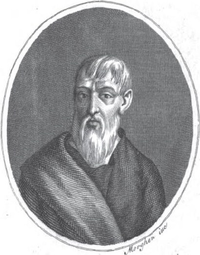Herodicus (Greek: Ἡρóδιĸος) was a 5th century BC Greek physician, dietician, sophist, and gymnastic master (παιδοτρίβης).[1][2] He was born in the city of Selymbria, a colony of the city-state Megara, and practiced medicine in various Greek cities including Selymbria, Megara, Athens, and Cnidos.[1][3] Herodicus believed that exercise and a good diet are key foundations of health, and emphasized the use of both to treat various ailments.[1] He may have also been one of the tutors of Hippocrates.[1] He also recommended massage using beneficial herbs and oils.[4] His theories are considered the foundation of sports medicine.

History
editHerodicus is credited with being the first physician to practice what would become known as therapeutic gymnastics.[2] Herodicus noticed that weak wrestling and boxing athletes gained strength when subjected to rigorous exercise.[2] This observation led Herodicus to start prescribing exercise as a treatment and preventative measure against illness.[2] Maintaining health was just as important to Herodicus as restoring health.[2]
Some scholars believe Hippocrates, often called the father of medicine, was influenced by Herodicus. This is due to the attention Hippocrates gives to hygienic exercise.[2]
In Classical Greece, physicians were seldom allowed inside gymnasiums. Lack of exposure left most Greek physicians of the time unknowledgeable of the effects of exercise. Being both a gymnastics master and a physician gave Herodicus unique insight into the medical applications of exercise.[1] Herodicus is believed to have authored the Ars Gymnastica, a series of gymnastic exercises he used to treat febrile conditions and other illnesses.[5]
Euryphon, a mentor of Herodicus at the medical school of Cnidos, emphasized the importance of diet in maintaining health. He theorized that wastes created through bad digestion spread through the body and caused illness. Herodicus contributed to this theory by adding that proper digestion of food only occurs with subsequent exercise.[1] A failure to move after eating could cause a humoral imbalance between what Herodicus called "sharp and bitter" liquids. Herodicus believed that disease was caused by an imbalance in these two liquids in one or more internal organs.[1] This theory is similar to and may have influenced Hippocrates' humoral theory.[1]
Herodicus advocated also for the use of therapeutic massage. He was specific in the manner that a massage should be given. Herodicus recommended that massage should initially be slow and gentle, then subsequently faster, with the application of more pressure, which was followed by more gentle friction.[4]
Many contemporaries of Herodicus, such as Aristotle, criticized his methods as being too harsh and unpleasant.[1] Herodicus was accused by the author of Epidemics of killing patients with the intensity of his exercise routines.[1] According to Plato, Herodicus recommended that his patients walk from Athens to Megara, a distance of a little more than 20 miles.[3]
References
edit- ^ a b c d e f g h i j Georgoulis, Anastasios D.; Kiapidou, Irini-Sofia; Velogianni, Lamprini; Stergiou, Nicholas; Boland, Arthur (2006-09-02). "Herodicus, the father of sports medicine". Knee Surgery, Sports Traumatology, Arthroscopy. 15 (3): 315–318. doi:10.1007/s00167-006-0149-z. ISSN 0942-2056. PMID 16951976. S2CID 206888137.
- ^ a b c d e f Jack W. Berryman; Roberta J. Park, eds. (1992). Sport and exercise science: essays in the history of sports medicine. Urbana: University of Illinois Press. ISBN 0-252-01896-6. OCLC 24247632.
- ^ a b Plato. Protagoras. Translated by Walter Rangeley Maitland Lamb. Loeb Classical Library. Retrieved 2021-11-12 – via ToposText.
- ^ a b Early American Manual Therapy (Version 5.0) - Chapter 1 History and Development of Mechanical Vibration Therapy Archived 2005-03-09 at the Wayback Machine, Accessed: October 6, 2008. "In the 5th century Herodicu advocated exercise the treatment of disease and compelled his patients to have their bodies rubbed, he being a firm believer in the efficacy of massage. Joseph SChreiber, M. D., author of "Treatment of Massage and Exercise," translated by Walter Mendelson, M. D., of New York, claims that Herodicus first laid down principles for rational, mechanical methods of treatment. HERODICUS, 484 B. C., was one of the first to refer to the manner of giving massage. He said friction should be gentle and slow at first, then rapid in combination with pressure, which was to be followed by gentle friction. Other advocates were Plato, Socrates, and Hippocrates, who said "rubbing can bind a joint that is too loose, and loosen a joint that is too rigid. Hard rubbing binds, soft rubbing loosens, much rubbing causes parts to waste, moderate rubbing makes them grow." This is the earliest definite information relative to the effect of variations in the application of massage. These maxims should be remembered by those who use mechanical vibration for they well define its general therapeutic application. Hipppocrates also suggested the direction in which to apply massage the art of rubbing up, thereby assisting mechanical and physical processes, aiding circulation, relieving stasis and consequently quickening metabolic processes."
- ^ Dreeben-Irimia, Olga (2011). Introduction to physical therapy for physical therapist assistants (2nd ed.). Sudbury, MA: Jones & Bartlett Learning. ISBN 978-0-7637-8130-9. OCLC 624405323.
Further reading
edit- Londinensis., Anonymus (1947). The medical writings of Anonymus Londinensis. Univ. Press. OCLC 1134523998
- Martí-Ibáñez, F. A Prelude to Medical History. New York, MD Publications, 1961.
- Whiteside, J., Andrews, J. Trends for the Future as a Team Physician: Herodicus to Hereafter, Сlinics in Sports Medicine. Volume 26, Issue 2, April 2007, рр. 285—304.